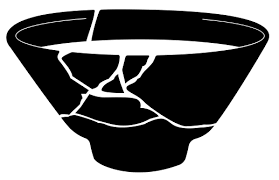
I have often seen people wondering about Kintsukuori, the Japanese art of Golden Repair or Golden Mend, and Kintsugi, the art of gold joinery. Of course, it is arguable of the fact that both are significantly the same thing. The original Kintsugi stayed linked to gold and the golden glue. However, contemporary Kintsugi mix different range of colors such as silver and rose gold.
The focus stays around the early Japanese philosophy of Wabi-Sabi – appreciation of flaws. Kintsugi, the practice to repair by restricting the damaged parts to restore it to its original form. The golden cracks spread around the final restored piece makes it even more appealing and idealistic.
Of course, It is deeper than just art. It conveys that humans may, occasionally, chip and break and need repairs. Things whether relations or scenes that hurt us now, over time heal and nurture us into unique and ‘ideal’ characters, just like the cracked ceramics that have been repaired through Kintsugi.

It further suggests that when people sometimes crack or break under circumstances, they cannot be thrown away. The ‘wear and tear’ is not a shame! With time, we heal and grow. The kintsugi craftspeople who repaired the shogun’s bowl with gold saw imperfections as gifts to be worked with, not shames to be hidden. People survive blows to the ego and to their reputations, or health, and go on to live to tell the tale. The lines of time, rigour, and roughness ought to be the source of inspiration and admiration.

Lately, the concept has grabbed attention of the artists, and can be noticed in jewellery and crockeries. The ‘golden repair’ is a therapeutic and enjoyable process that can be carried out in your own house. Follow the steps to create your own masterpiece:
1) Arrange epoxy glue, gold powder, stirring sticks, brushes, and broken ornaments.
2) Piece everything together and then glue them together for 10 minutes and try to pry them apart to form a base.
3) Now mix glue with the gold powder

4) Brush the golden glue mixture along the edge. We advise you to do it before the glue dries off. Once fixed together, hold it in position for 2-3 minutes.
5) Keep repeating this process till you have the whole piece fixed.
Hopefully, you discovered the entire process rather therapeutic, and the lessons satisfying enough to extend to numerous other bonding activities.
(Edited by Monica P Singhal)
The featured image of Kintsugi art curtsy of Morty Bachar www.lakesidepottery.com
Aashi is a working PR professional who enjoys a good amount of her free time reading, cooking, and taking care of her 2 dogs.